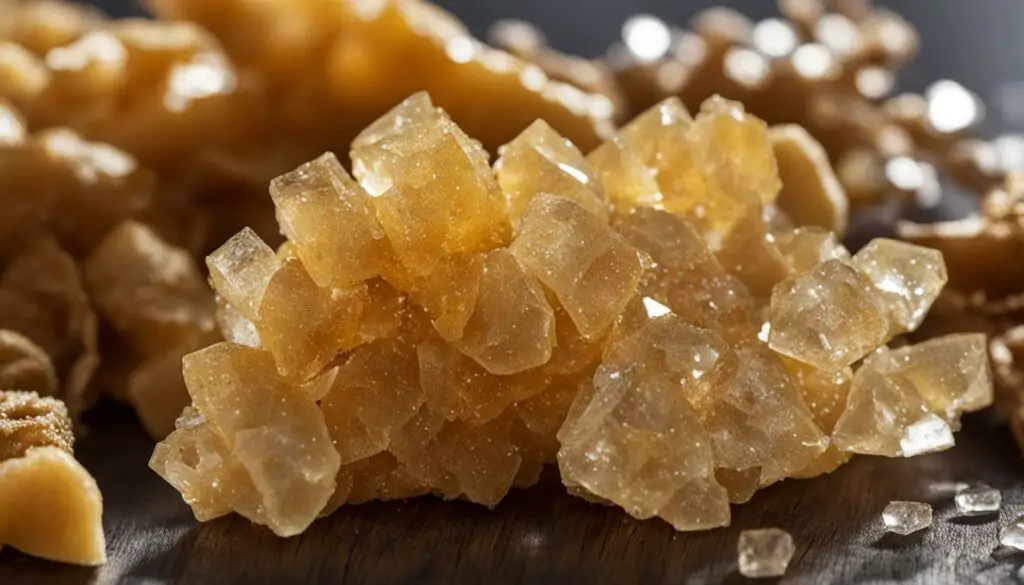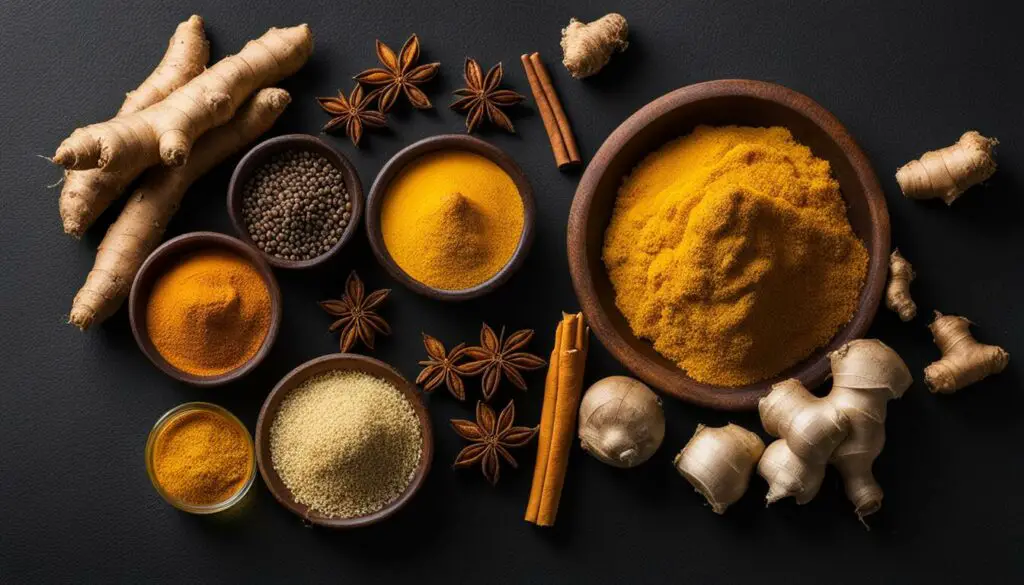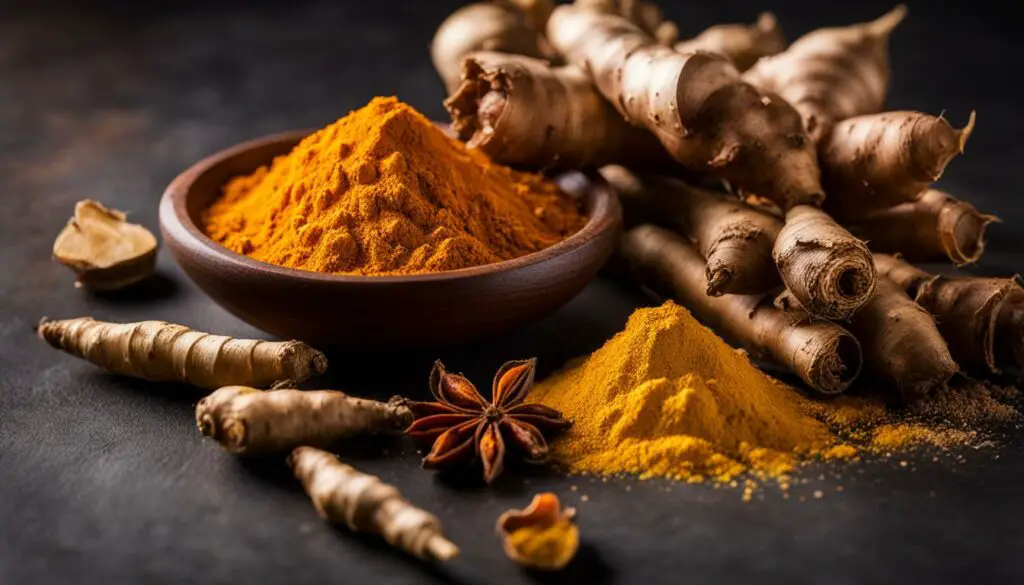Originally posted on December 5, 2023 @ 1:30 am
When you’re in the middle of cooking and realize you’re out of fresh ginger, don’t worry! There are plenty of alternatives you can use to add a burst of flavor to your dishes. While nothing can quite match the unique heat and taste of grated ginger, these substitutes can still elevate your recipes. In this guide, we’ll explore the best options for grated ginger replacements.
Table of Contents
Key Takeaways:
- When fresh ginger is not available, you can use ground ginger, dried spices, crystallized ginger, or frozen fresh ginger as substitutes.
- Ground ginger can be used in savory recipes, while dried spices like allspice, cardamom, cinnamon, mace, and nutmeg can complement different dishes.
- Crystallized ginger adds a touch of sweetness to your recipes, and freezing fresh ginger allows for convenient use.
- Galangal is a root similar to ginger and can be used as a substitute if you can find it.
- Allspice, cinnamon, and nutmeg can be used as substitutes in baking.
Ground Ginger
Ground ginger is a common substitute for fresh grated ginger in recipes. While it is milder and less aromatic than fresh ginger, it can still add a hint of ginger flavor. To substitute, use 1/4 teaspoon of ground ginger for every 1 tablespoon of fresh grated ginger called for in the recipe. Keep in mind that ground ginger may have a diminished flavor if it is not fresh. Ground ginger can be used in various dishes and is especially suitable for savory recipes.
Comparison Table: Ground Ginger vs Fresh Grated Ginger
| Ground Ginger | Fresh Grated Ginger | |
|---|---|---|
| Taste | Milder and less aromatic | Bolder and more aromatic |
| Flavor Intensity | Diminished if not fresh | Fresher and more pronounced |
| Texture | Powdery | Fibrous and pulpy |
| Usage | Various dishes, especially savory | Wide range of dishes, adds depth of flavor |
| Availability | Readily available in most grocery stores | Available but may vary in freshness and quality |
“Ground ginger is a versatile substitute for fresh grated ginger in cooking. It may not offer the exact same flavor profile, but it can enhance the taste of your dishes. Just remember to adjust the quantity to maintain the desired intensity. Experiment with different ratios to find the perfect balance for your recipe.”
When using ground ginger as a substitute, it’s important to note that fresh grated ginger provides a bolder and more aromatic flavor compared to its powdered counterpart. However, ground ginger can still add a pleasant hint of ginger to your dishes, especially in savory recipes. It’s readily available in most grocery stores and can be a convenient alternative when fresh ginger is not available.
Ginger Alternatives: Exploring Substitutes for Grated Ginger in Cooking

When fresh ginger is not available, there’s no need to worry. There are several ginger substitutes that can bring a unique flavor profile to your cooking. In this section, we will explore various alternatives to grated ginger and how they can be used in your recipes. Whether you’re looking for a milder flavor or a different aromatic twist, these ginger alternatives will add a delightful twist to your dishes.
Dried Spices
One of the most accessible substitutes for grated ginger is dried spices. While they may not provide the exact same flavor, they can offer complementary notes to enhance your recipes. Consider using spices like allspice, cardamom, cinnamon, mace, or nutmeg. These spices can be used in equal amounts as the grated ginger called for in the recipe, or you can experiment with different ratios to achieve your desired flavor profile.
Crystallized Ginger
Another interesting substitute is crystallized ginger, also known as candied ginger or glace ginger. It has a sweet and spicy flavor that can add a unique twist to your dishes. To use crystallized ginger as a substitute, you can use 1/8 teaspoon of ground ginger for every 1 tablespoon of crystallized ginger called for in the recipe. Keep in mind that additional sugar may be needed to taste. However, note that ground ginger may not be a suitable substitute for crystallized ginger as a garnish.
Frozen Fresh Ginger
If you’re a fan of using fresh ingredients, freezing ginger is a great option. By keeping a ginger root in your freezer, you can easily grate as much as you need for a recipe while keeping the rest for future use. The best part is that frozen fresh ginger doesn’t require thawing before use, making it convenient and efficient. With frozen fresh ginger, you can always have a supply of ginger on hand whenever you need it.
| Ginger Substitute | Usage |
|---|---|
| Dried Spices | Use in equal amounts as grated ginger or experiment with ratios. |
| Crystallized Ginger | Substitute 1/8 teaspoon ground ginger for every 1 tablespoon of crystallized ginger. |
| Frozen Fresh Ginger | Grate frozen ginger as needed, no need to thaw. |
With these ginger alternatives, you can continue to create delicious meals and explore new flavors in your cooking. Whether it’s through dried spices, crystallized ginger, or frozen fresh ginger, there’s no limit to the delightful possibilities that await you in the kitchen.
Crystallized Ginger: A Delicious Substitute for Fresh Grated Ginger

When you’re in need of a substitute for fresh grated ginger, look no further than crystallized ginger. Also known as candied ginger or glace ginger, this sweet and tangy treat can add a delightful burst of flavor to your dishes. Crystallized ginger is made by cooking fresh ginger in sugar water and then coating it in sugar, creating a unique texture and taste.
To use crystallized ginger as a substitute, simply replace 1 tablespoon of fresh grated ginger with 1/8 teaspoon of ground ginger. Keep in mind that ground ginger may not provide the same level of sweetness or texture, so you may need to adjust the sugar in your recipe accordingly. Crystallized ginger works particularly well in baked goods, desserts, and sweet marinades, infusing them with a warm and zesty ginger flavor.
When using crystallized ginger in your recipes, it’s important to note that it may not be suitable as a garnish due to its texture. However, its bold flavor and chewy consistency can add a delightful twist to your culinary creations. Whether you’re making gingerbread cookies, stir-fry dishes, or even cocktails, crystallized ginger can be a delicious substitute for fresh grated ginger.
Table: Comparison of Ginger Substitutes
| Ginger Substitute | Flavor Profile | Usage | Ratio |
|---|---|---|---|
| Ground Ginger | Mild, less aromatic | Savory recipes | 1/4 tsp per 1 tbsp of fresh ginger |
| Dried Spices (Allspice, Cardamom, Cinnamon, Mace, Nutmeg) | Varies, can complement dishes | Equal amounts to grated ginger | Experiment with different ratios |
| Crystallized Ginger | Sweet, tangy | Baked goods, desserts, sweet marinades | 1/8 tsp ground ginger per 1 tbsp of crystallized ginger |
| Frozen Fresh Ginger | Similar to fresh grated ginger | Various recipes | Use as needed |
| Galangal | Similar to fresh ginger | Various recipes | Equal amounts to grated ginger |
Table: A comparison of different ginger substitutes and their flavor profiles, usage, and ratios in recipes.
Frozen Fresh Ginger

When you find yourself without fresh ginger, one of the best substitutes to consider is frozen fresh ginger. Freezing ginger is a simple and convenient way to have a readily available supply on hand for your cooking needs. Plus, it retains most of its flavor and aroma when properly stored in the freezer.
To freeze fresh ginger, start by purchasing a ginger root from your local grocery store or farmers market. Choose a root that is firm and free from any mold or soft spots. Then, peel the ginger using a vegetable peeler or the edge of a spoon to remove the skin. Next, grate or chop the ginger into small pieces according to your recipe’s requirements.
Place the grated or chopped ginger in a freezer-safe container or bag, making sure to remove any excess air before sealing. Label the container with the date, as ginger can be stored in the freezer for up to six months. When you need to use frozen ginger in a recipe, simply remove the desired amount and add it directly to your dish. There’s no need to thaw the ginger beforehand, as it can be used directly from the freezer.
Tips for Storing and Growing Ginger

Properly storing ginger is essential to maintain its freshness and flavor. There are a few different methods you can use to store ginger and ensure it stays in optimal condition.
Freezing Ginger
One of the best ways to store ginger is by freezing it. This method allows you to have a readily available supply of ginger on hand whenever you need it. Simply keep a ginger root in your freezer and grate as much as you need for a recipe. The rest can be put back in the freezer for future use. Freezing ginger does not require thawing before use, making it convenient and efficient.
Room Temperature Storage
If you prefer to have ginger readily available at room temperature, you can store it in a cool, dry place. Choose a spot away from direct sunlight and moisture, such as a pantry or kitchen cabinet. Make sure the ginger is dry before storing to prevent it from rotting. This method allows the ginger to last for several weeks, but it may start to lose its freshness over time.
Refrigerator Storage
Another option for storing ginger is in the refrigerator. Place the ginger in a plastic bag or airtight container and store it in the vegetable drawer. This method can help extend the shelf life of ginger for up to one month. However, keep in mind that refrigeration may cause the ginger to become more fibrous and less potent in flavor.
Growing Ginger
If you want to ensure a fresh supply of ginger whenever you need it, consider growing your own. Ginger can be grown as a flowering plant on your windowsill or in a garden if you live in a suitable climate. To grow ginger, you’ll need a root from the grocery store that has sprouting buds. Plant the root in a pot with well-draining soil and keep it in a warm, sunny spot. With proper care and watering, your ginger plant will grow, and you can harvest fresh ginger whenever you need it.
By following these tips for storing and growing ginger, you can ensure that you always have a fresh supply on hand. Whether you choose to freeze, store at room temperature, refrigerate, or grow your own, ginger substitutes will become a thing of the past.
Galangal as a Substitute

If you’re looking for an alternative to fresh grated ginger, galangal is a great option to consider. This root is part of the same plant family as ginger and can be used as a substitute in many recipes. While it may be more challenging to find in the United States, it is typically available at specialty international grocery stores.
To use galangal as a substitute for fresh ginger, simply peel the root and grate it as you would with ginger. The flavor of galangal is similar to ginger but with a slightly more citrusy and earthy taste. It adds a unique and exotic flavor to dishes, making it a popular choice in Southeast Asian cuisine.
Keep in mind that galangal may not be an exact replacement for ginger in terms of flavor, so you may need to adjust the quantity based on your personal preference. Experiment with different ratios to find the right balance for your recipe. Whether you’re making a stir fry, curry, or soup, galangal can bring a delightful twist to your dishes as a substitute for fresh grated ginger.
Table: Galangal vs. Ginger
| Ingredient | Flavor | Usage |
|---|---|---|
| Galangal | Citrusy and earthy | Southeast Asian cuisine, curries, stir-fries |
| Ginger | Spicy and aromatic | Asian, Indian, and Middle Eastern cuisine, marinades, baked goods |
As seen in the table above, galangal and ginger have distinct flavors and are commonly used in different types of cuisine. While they share similarities, it’s important to note the differences when using galangal as a substitute for ginger. Be adventurous in your cooking and explore the unique flavors that galangal can bring to your dishes.
Allspice as a Ginger Substitute in Baking

When it comes to baking and finding a suitable substitute for grated ginger, allspice can be a fantastic option. It possesses warm and peppery notes that can mimic the unique flavor profile of ginger. This versatile spice can be used as a 1:1 substitute in recipes that call for ginger, making it easy to incorporate into your favorite baked goods. Whether you’re baking cookies, cakes, or bread, allspice can add a cozy and aromatic touch to your creations.
| Allspice | Ginger |
|---|---|
| Warm and peppery flavor. | Distinctive heat and flavor. |
| Can be used as a 1:1 substitute in baking recipes. | Requires experimentation with ratios for substitution. |
| Provides a cozy and aromatic touch to baked goods. | Brings a unique and bold flavor to dishes. |
By using allspice as a ginger substitute, you can still achieve delightful flavors and aromas in your baked treats. Whether you’re making gingerbread, spice cake, or pumpkin muffins, allspice can seamlessly replace grated ginger to create a delicious and satisfying result. Experiment with different spice combinations and ratios to find the perfect balance of flavors that suits your taste preferences.
Benefits of Using Allspice as a Ginger Substitute in Baking
- Allspice provides warmth and depth of flavor similar to ginger.
- It is readily available in most grocery stores.
- Allspice is versatile and can be used in various baked goods.
- Using allspice as a substitute allows you to maintain the desired flavor profile of ginger in your recipes.
“Allspice adds a cozy and aromatic touch to my gingerbread cookies. It’s the perfect substitute for fresh grated ginger!” – Baking Enthusiast
So, the next time you find yourself without fresh grated ginger while baking, don’t worry. Just reach for the allspice in your pantry and get creative with your recipes. Embrace the warm and peppery flavors that allspice brings, and enjoy the delicious results in your favorite baked treats.
Ginger Substitutes in Baking: A Flavorful Combination of Cinnamon and Nutmeg
When it comes to baking, finding the right substitute for grated ginger is essential to achieve the desired flavors in your favorite recipes. One option that can add depth and warmth to your baked goods is a combination of cinnamon and nutmeg. This duo creates a flavor profile reminiscent of ginger, making it a suitable alternative when fresh grated ginger is not available.
To use cinnamon and nutmeg as ginger substitutes in baking, start by combining equal amounts of these spices. For example, if the recipe calls for 1 tablespoon of fresh grated ginger, you can use 1/2 tablespoon of cinnamon and 1/2 tablespoon of nutmeg. Adjust the ratio based on your personal taste preferences.
This combination works particularly well in sweet baked goods where ginger is typically used, such as gingerbread cookies, cakes, and muffins. The warm, aromatic notes of cinnamon and the slightly spicy flavor of nutmeg complement each other to create a delightful alternative to ginger.
| Benefits of Cinnamon and Nutmeg Combination as Ginger Substitutes in Baking |
|---|
| 1. Provides a warm and aromatic flavor profile |
| 2. Adds depth and complexity to baked goods |
| 3. Balances the strong bite of nutmeg with the sweetness of cinnamon |
| 4. Suitable for a wide range of sweet baked goods |
Next time you’re baking and find yourself without fresh grated ginger, don’t worry. Reach for cinnamon and nutmeg and enjoy the delicious flavors they bring to your creations. Remember to adjust the quantities based on your preferences and experiment with different combinations to find the perfect ginger substitute for your baking needs.
Ginger Substitute Recipe Ideas

When you’re in need of a ginger substitute in your recipes, there are plenty of options to choose from. These alternatives can add unique flavors and aromas to your dishes, allowing you to create delicious meals even without fresh grated ginger. Here are some recipe ideas that incorporate ginger substitutes:
1. Stir Fry Dishes
- Ginger Substitute: Ground ginger or dried spices like allspice or cardamom.
- Recipe Idea: Try making a flavorful stir fry with your choice of protein, vegetables, and a ginger substitute. Sauté the ingredients in a hot pan with oil, garlic, and your chosen substitute. Serve over steamed rice or noodles for a satisfying meal.
2. Savory Marinades
- Ginger Substitute: Frozen fresh ginger or galangal.
- Recipe Idea: Create a tangy and aromatic marinade for meats or vegetables using your ginger substitute of choice. Combine ingredients like soy sauce, vinegar, oil, garlic, and your chosen substitute. Marinate the protein of your choice for several hours or overnight before grilling or roasting.
3. Baked Goods
- Ginger Substitute: Allspice and cinnamon combo or ground ginger.
- Recipe Idea: Prepare delectable baked treats like gingerbread cookies or cakes using your ginger substitute. Experiment with different ratios of allspice and cinnamon to achieve a flavor profile similar to ginger. Alternatively, use ground ginger as a direct substitute for grated ginger in sweet baked goods.
By incorporating these ginger substitutes into your recipes, you can still enjoy the unique flavors and aromas that ginger brings. Don’t be afraid to get creative and experiment with different combinations to find your preferred substitution. Whether you’re making stir fry dishes, savory marinades, or baked goods, these substitutes will add a delightful touch to your culinary creations.
Storing and Using Fresh Ginger
When it comes to using fresh ginger, proper storage and preparation are key to preserving its freshness and flavor. Whether you have leftover ginger or want to stock up for future use, there are a few methods you can employ to ensure that your ginger stays fresh and ready to enhance your culinary creations.
One effective method of storing fresh ginger is to freeze it. Freezing ginger not only extends its shelf life but also makes it convenient to have on hand whenever you need it. To freeze fresh ginger, simply place the whole unpeeled root in a freezer bag and store it in the freezer. When you’re ready to use it, grate or slice off the desired amount and return the remaining ginger to the freezer. This way, you can have fresh ginger at your fingertips without worrying about it going bad.
If freezing isn’t your preferred method, you can also store fresh ginger at room temperature or in the refrigerator. To store ginger at room temperature, choose a cool, dry place away from direct sunlight. Simply place the unpeeled ginger root in a paper bag or airtight container, and it should stay fresh for up to a week. If you opt to store ginger in the refrigerator, keep it in a resealable bag or airtight container. This will help retain its moisture and prevent it from drying out. Stored this way, fresh ginger can last for up to three weeks.
When it comes time to use fresh ginger in your recipes, it’s essential to properly prepare it. Start by peeling off the thin, papery skin using a spoon or a vegetable peeler. Then, depending on your recipe, you can either grate, mince, slice, or julienne the ginger to the desired size. Remember, the finer the ginger is chopped or grated, the more intense its flavor will be in your dish. So be sure to adjust accordingly based on your personal taste preferences.
Conclusion
When it comes to cooking and finding the perfect flavor profile, having a backup plan for grated ginger is essential. Fortunately, there are several ginger substitutes that can meet your culinary needs. Ground ginger, dried spices like allspice and cinnamon, crystallized ginger, and even frozen fresh ginger are all viable alternatives. Experimenting with these options will help you discover the best substitute for your recipes.
Remember to properly store and use fresh ginger to ensure its quality and maximize its shelf life. Freezing fresh ginger is a convenient method to always have it on hand. Whether you choose to grow ginger yourself or purchase it from a store, following proper storage techniques is key to maintaining its freshness.
So the next time you find yourself without grated ginger, don’t worry. With these ginger substitutes, you can still achieve the desired flavors and aromas in your favorite dishes. Whether it’s a stir-fry, a savory marinade, or a delightful batch of cookies, these alternatives will help you create delicious meals without the need for fresh grated ginger.
FAQ
What can I use as a substitute for grated ginger?
There are several alternatives you can use, such as ground ginger, dried spices like allspice and cinnamon, crystallized ginger, frozen fresh ginger, and even galangal.
How much ground ginger can I use as a substitute for fresh grated ginger?
You can use 1/4 teaspoon of ground ginger for every 1 tablespoon of fresh grated ginger called for in the recipe.
Can I use dried spices as substitutes for grated ginger?
Yes, you can use spices like allspice, cardamom, cinnamon, mace, and nutmeg as alternatives to grated ginger. Use them in equal amounts as the grated ginger called for in the recipe.
How much crystallized ginger should I use as a substitute for fresh grated ginger?
You can use 1/8 teaspoon of ground ginger for every 1 tablespoon of crystallized ginger called for in the recipe. Additional sugar may be needed to taste.
Can I freeze fresh ginger for later use?
Yes, freezing fresh ginger is a great way to have a readily available supply. Simply keep a ginger root in your freezer and grate as much as you need for a recipe.
How should I store fresh ginger?
You can store fresh ginger in the freezer, at room temperature in a cool, dry place, or in the refrigerator. To ensure freshness, peel the skin and grate as much as needed for the recipe.
What is galangal and can I use it as a substitute for fresh ginger?
Galangal is another root in the same plant family as ginger. It can be used as a substitute for fresh ginger, although it may be more challenging to find in the United States.
Can I use allspice as a substitute for ginger in baking?
Yes, allspice can be a suitable option. Use it as a 1:1 substitute in recipes that call for ginger, especially in baked goods where ginger is used as a cozy spice.
Can I use a combination of cinnamon and nutmeg as a substitute for ginger in baking?
Yes, this duo can balance out the strong bite of nutmeg and create a flavor profile reminiscent of ginger. It works well in sweet baked goods.
What are some recipe ideas where I can use ginger substitutes?
You can incorporate ginger substitutes in stir fry dishes, fried rice, savory marinades, and even certain baked goods.
How should I store and use fresh ginger?
Freezing fresh ginger, storing it at room temperature or in the refrigerator, and properly peeling and grating as needed are all key to maintaining its freshness and flavor.
Source Links
- https://www.acouplecooks.com/best-ginger-substitute/
- https://www.thespruceeats.com/ground-ginger-substitute-1388884
- https://rawspicebar.com/blogs/spices-101/ginger-substitute
See also:
Leave a Reply